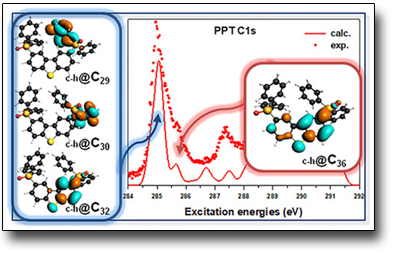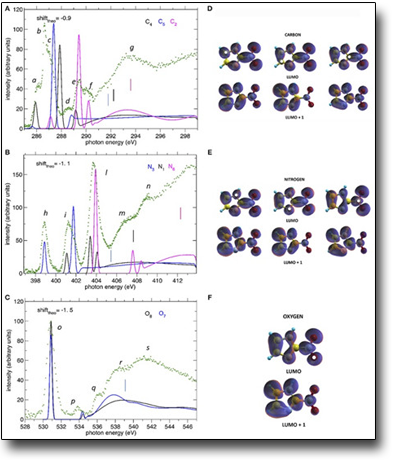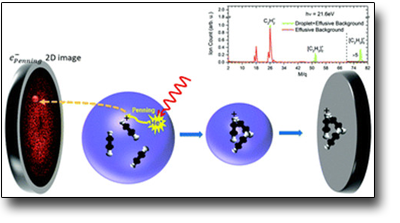
Marcello Coreno -
Robert Richter (Elettra-ST)
Michele Alagia (CNR-IOM)
Kevin C. Prince (Elettra-ST)
Fabio Zuccaro -
Monica de Simone (CNR-IOM)
Cesare Grazioli (CNR-IOM)
Lorenzo Avaldi -
Scientific Activity
The Gas Phase Photoemission beamline of the Elettra synchrotron radiation ring (Trieste, Italy) is the only one specifically devoted to gaseous systems. It is operated by a joint Research Team of Elettra Sincrotrone Trieste and Italian National Research Council, offering a multi-technique approach for investigation of electronic properties of free atoms, molecules and clusters in a wide energy range (CNR-IOM and CNR-ISM).
The source is a 36 period planar undulator. The monochromator is a Variable Angle Spherical Grating Monochromator, with five gratings and a photon energy range 13-900 eV(Iph> 1011 ph/s; E/E > 104 ). It delivers high flux (up to 1014ph/s, at100 eV, 0.1% bandwidth), with good resolving power (E/ΔE ≥ 10000) and small spot size (≈250 µm) at the target. At variance with other beam lines at the ELETTRA, the end-station is not fixed, but several interchangeable apparatuses are available for users’ experiments and users can also bring their own apparatus to perform experiments, provided that it is compatible with beamline requirements. Two exit ports are available for experiments: the GasPhase main line (hv range : 13-900 eV) and the GasPhase branchline (hv range: 13-250 eV). At both main line and branch line a differential pumping section is settled, in order to decouple the UHV section of the mirror chambers from the high vacuum in the experimental end station (up to 5 orders of magnitude difference in pressure). On the branch-line, a ps-laser, tunable in the range 700-1000 nm (Tsunami, SpectraPhysics, ~83 MHz) is available. It can be synchronized to synchrotron radiation at 1/6th of the storage ring frequency (~83 MHz) for pump-probe experiments.
The active in-house and users' research program at GasPhase covers the following areas of activity:
- high resolution studies of electronic structure and dynamics of atoms and molecules (with core level photoabsorption, photoemission and dispersed fluorescence);
- characterization of reactive gases, radicals, transient species (electron and ion coincidence spectroscopies;
- studies of complex molecules (biological and other organic molecules, and organometallic complexes);
- studies of inorganic and organic clusters;
- studies of electron correlation in atoms and molecules after double photoionization, and inner shell ionization and decay;
- novel instrumentation for investigation of many body interactions in complex systems.
Strumentations
The beamline is presently equipped with several distinct interchangeable set-ups:
- Multi-coincidence experiments set up, for angle resolved and electron-electron coincidence experiments in a versatile multichannel configuration (fig. 2); PEPECO
- VG-220i set up for photoemission and mass spectrometry of condensable vapours, equipped for ion-electron coincidences
- Velocity Map Imaging set up (VMI and PEPICo) PEPICO
- Molecular beam set up, for PEPICo mass spectroscopy.
- ARPES, angle-resolved photoemission experiments on aggressive molecular species (radicals, transients, reactive species).
- SCIENTA SES-200 electron analyzer (Fig. 4; in collaboration with Uppsala University).
- PIFS and XUV-PIK, for dispersed emission experiments with an UV-Vis monochromator and/or a compact XUV spectrometer (in collaboration with IFN-CNR, Padua) PIFS
- CESyRa "Cluster Experiment with Synchrotron Radiation" for photoionization of clusters of refractory materials, via electron-ion multicoincidence (in collaboration with prof. Paolo Piseri, University of Milan and NFFA).
The paper reports on the comprehensive gas phase electronic structure characterization of PPT (2,8-bis(diphenylphosphoryl) -dibenzo[b,d]thiophene), a promising ambipolar phosphorescent host material recently introduced in organic light-emitting diodes (OLEDs). This system can be considered formed by two diphenylphosphine oxide (dPPO) moieties functionalizing the small dibenzothiophene (DBT) core. PPT is characterized by high triplet energy. The triphenyl phosphine oxide (TPPO) molecule has been chosen as the model compound of the dPPO groups in PPT. A combined experimental and theoretical study by density functional theory of the gas phase electronic structure of TPPO and PPT has been performed through X-ray photoelectron spectroscopy and near-edge X-ray absorption fine structure spectroscopy measured at the carbon and oxygen 1s regions.
with permission from {A. Guarnaccio, et al, The Journal of Physical Chemistry C 124 ,9774}. Copyright {2020} American Chemical Society."
 The NEXAFS spectra of 2-nitroimidazole measured at the C, N, and O K edge and the iso-surfaces for the LUMO and LUMO+1 orbitals at all calculated excitation channels. The white dots indicate the sites of excitation. .
The NEXAFS spectra of 2-nitroimidazole measured at the C, N, and O K edge and the iso-surfaces for the LUMO and LUMO+1 orbitals at all calculated excitation channels. The white dots indicate the sites of excitation. .Tunability and selectivity of synchrotron radiation have been used to study the excitation and ionization of 2-nitroimidazole at the C, N, and O K-edges. The combination of a set of different measurements (X-ray photoelectron spectroscopy, near-edge photoabsorption spectroscopy, Resonant Auger electron spectroscopy, and mass spectrometry) and computational modeling have successfully disclosed local effects due to the chemical environment on both excitation/ionization and fragmentation of the molecule.
 NEXAFS spectrum of 2-nitroimidazole measured at the K threshold for C, N, and O K and isosurfaces of the LUMO and LUMO + 1 orbitals
NEXAFS spectrum of 2-nitroimidazole measured at the K threshold for C, N, and O K and isosurfaces of the LUMO and LUMO + 1 orbitals
 Schematic of the VMI-PEPiCo experiment on acetylenic oligomers in He nanodrops
Schematic of the VMI-PEPiCo experiment on acetylenic oligomers in He nanodrops
 English (UK)
English (UK)  Italiano (Italia)
Italiano (Italia)